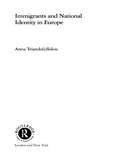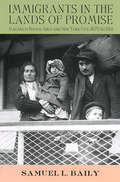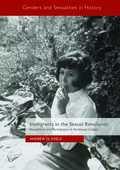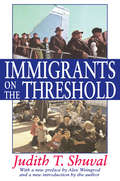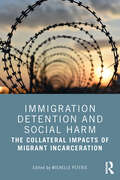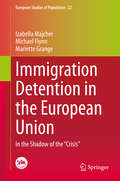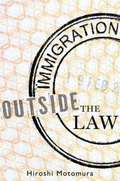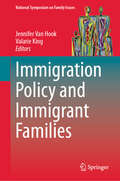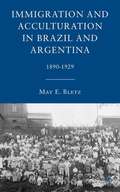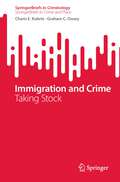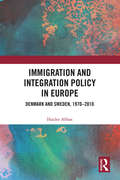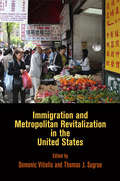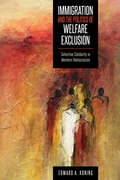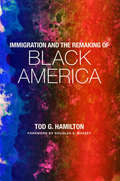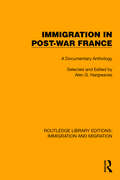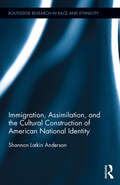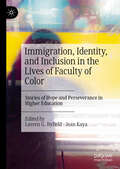- Table View
- List View
Immigrants Under Threat: Risk and Resistance in Deportation Nation (Latina/o Sociology #5)
by Greg PrietoCo-Winner, 2019 Latina/o Section Distinguished Contribution to Research Book Award, given by the American Sociological AssociationA portrait of two Mexican immigrant communities confronting threats of deportation, detention, and dispossession Everyday life as an immigrant in a deportation nation is fraught with risk, but everywhere immigrants confront repression and dispossession, they also manifest resistance in ways big and small. Immigrants Under Threat shifts the conversation from what has been done to Mexican immigrants to what they do in response. From private strategies of avoidance, to public displays of protest, immigrant resistance is animated by the massive demographic shifts that started in 1965 and an immigration enforcement regime whose unprecedented scope and intensity has made daily life increasingly perilous. Immigrants Under Threat focuses on the way the material needs of everyday life both enable and constrain participation in immigrant resistance movements. Using ethnographic research from two Mexican immigrant communities on California’s Central Coast, Greg Prieto argues that immigrant communities turn inward to insulate themselves from the perceived risks of authorities and a hostile public. These barriers are overcome through the face-to-face work of social-movement organizing that transforms individual grievances into collective demands. The social movements that emerge are shaped by the local political climates in which they unfold and remain tethered to their material inspiration. Immigrants Under Threat explains that Mexican immigrants seek not to transcend, but to burrow into American institutions of law and family so that they might attain a measure of economic stability and social mobility that they have sought all along.
Immigrants and Minorities in British Society (Routledge Library Editions: Racism and Fascism #9)
by Colin HolmesThis book, first published in 1978, examines the debate over immigration into Britain and raises the important point that the existence in the country of immigrant and minority groups is nothing new. Britain has, in fact, attracted newcomers throughout most of its history and it is to remedy the deficiency of research and knowledge about these early immigration processes that the present volume has been put together. Composed of a number of essays written from different perspectives by specialists in different areas, it attempts overall to provide a tightly integrated review of the major research areas, themes and problems involved in immigration studies.
Immigrants and National Identity in Europe (Routledge Advances in Sociology)
by Anna TriandafyllidouThe author reviews main theories of nationalism and criticises their lack of elaboration on the role of 'Others' in nation formation. Drawing upon anthropological, sociological and social psychological perspectives, she develops a dynamic, relational perspective for the study of national theory.
Immigrants in Prairie Cities
by Royden Loewen Gerald FriesenOver the course of the twentieth century, sequential waves of immigrants from Europe, Asia, Latin America, and Africa settled in the cities of the Canadian Prairies. In Immigrants in Prairie Cities, Royden Loewen and Gerald Friesen analyze the processes of cultural interaction and adaptation that unfolded in these urban centres and describe how this model of diversity has changed over time. The authors argue that intimate Prairie cities fostered a form of social diversity characterized by vibrant ethnic networks, continuously evolving ethnic identities, and boundary zones that facilitated intercultural contact and hybridity.Impressive in scope, Immigrants in Prairie Cities spans the entire twentieth century, and encompasses personal testimonies, government perspectives, and even fictional narratives. This engaging work will appeal to both historians of the Canadian Prairies and those with a general interest in migration, cross-cultural exchange, and urban history.
Immigrants in the Lands of Promise: Italians in Buenos Aires and New York City, 1870–1914 (Cornell Studies in Comparative History)
by Samuel L. BailyMost studies of immigration to the New World have focused on the United States. Samuel L. Baily's eagerly awaited book broadens that perspective through a comparative analysis of Italian immigrants to Buenos Aires and New York City before World War I. It is one of the few works to trace Italians from their villages of origin to different destinations abroad.Baily examines the adjustment of Italians in the two cities, comparing such factors as employment opportunities, skill levels, pace of migration, degree of prejudice, and development of the Italian community. Of the two destinations, Buenos Aires offered Italians more extensive opportunities, and those who elected to move there tended to have the appropriate education or training to succeed. These immigrants, who adjusted more rapidly than their North American counterparts, adopted a long-term strategy of investing savings in their New World home. In New York, in contrast, the immigrants found fewer skilled and white-collar jobs, more competition from previous immigrant groups, greater discrimination, and a less supportive Italian enclave. As a result, rather than put down roots, many sought to earn money as rapidly as possible and send their earnings back to family in Italy.Baily views the migration process as a global phenomenon. Building on his richly documented case studies, the author briefly examines Italian communities in San Francisco, Toronto, and Sao Paulo. He establishes a continuum of immigrant adjustment in urban settings, creating a landmark study in both immigration and comparative history.
Immigrants in the Sexual Revolution
by Andrew Dj ShieldThis book focuses on the latter half of the twentieth century, when much of northwest Europe grew increasingly multicultural with the arrival of foreign workers and (post-)colonial migrants, whilst simultaneously experiencing a boom in feminist and sexual liberation activism. Using multilingual newspapers, foreign worker organizations' archives, and interviews, this book shows that immigrants in the Netherlands and Denmark held a variety of viewpoints about European gender and sexual cultures. Some immigrants felt solidarity with, and even participated in, European social movements that changed norms and laws in favor of women's equality, gay and lesbian rights, and sexual liberation. These histories challenge today's politicians and journalists who strategically link immigration to sexual conservatism, misogyny, and homophobia.
Immigrants on the Threshold
by Judith T. ShuvalThis first large-scale empirical work on the adjustment problems of immigrants in Israel is now updated with a new introduction by the author and a preface by Alex Weingrod. The extraordinary phenomenon of worldwide immigration to Israel has made this searching study of people in transit possible. "Immigrants on the Threshold" reports on the attitudes and behaviors of almost 2,000 people from twenty countries during their first year in Israel during the early years of mass migration. It is of particular interest as the phenomenon of integration becomes an issue for concern in many other parts of the world. "Immigrants on the Threshold" by Judith Shuval presents a theoretical framework closely intermeshed with rich empirical findings. No other work in this field approaches this study in either depth of theoretical analysis or in design and execution of data collection performed by conducting in-depth interviews and then using statistical analysis to quantify results in exacting and objective detail. It attempts to answer a number of critical questions: What factors in the immigrants' past and present condition their responses to the strain of transit? What is the role of commitment to the goal of the new society into which they must incorporate? What is the role of different social and economic backgrounds in determining patterns of acculturation? What factors affect the aspirations and mobility patterns of immigrants? The answers to these questions - the hypotheses formulated and the conclusions reached in "Immigrants on the Threshold" - contribute substantially to the fields of both sociology and social psychology. These answers, and the methods used to reach them, should be of interest to anyone in these fields and the field of applied social research, as well as those interested in Israel and questions of immigrant integration.
Immigration Detention and Social Harm: The Collateral Impacts of Migrant Incarceration
by Michelle PeterieThis interdisciplinary edited collection is the first internationally to comprehensively explore the harms immigration detention imposes beyond the ‘detainee’. Bringing together research from North America, the UK, Europe and Australia, it shows how the harms immigration detention imposes ramify beyond singular bodies, moments and locations – reverberating through families and communities and echoing across time.The book is structured in three parts. Part One: Human Costs, examines the harms immigration detention imposes on people who are not personally incarcerated, but whose lives are nonetheless entangled with detention regimes. Part Two: Societal Consequences highlights the corrosive impacts of immigration detention at the societal level, including the role migrant incarceration plays in naturalising and perpetuating inequalities and injustices. Part Three: Ending the Harm interrogates the possibilities of detention reform and detention abolition.This book will be a key reference text for scholars and students in the social and behavioural sciences who are interested in immigration detention, human rights and/or incarceration.
Immigration Detention in the European Union: In the Shadow of the “Crisis” (European Studies of Population #22)
by Michael Flynn Izabella Majcher Mariette GrangeThis book offers a unique comparative assessment of the evolution of immigration detention systems in European Union member states since the onset of the “refugee crisis.” By applying an analytical framework premised on international human rights law in assessing domestic detention regimes, the book reveals the extent to which EU legislation has led to the adoption of laws and practices that may disregard fundamental rights and standards. While emphasizing policies and laws adopted in response to the “refugee crisis,” the volume also shows how these policies have evolved—and in many cases grown more restrictive—even as the “crisis” has begun to recede from the borders of many European countries. To sharpen awareness of contrasting developments across the region, the book’s country chapters are organised into geographic sections that reveal how variations in migration pressures have in some cases resulted in contrasting detention practices even as the EU directives have sought to harmonise immigration laws. A critical focus of the book are the evolving domestic norms related to grounds for detention, length of detention, non-custodial "alternatives to detention," the treatment of children, and conditions of detention. With its systematic and comparative assessment of immigration detention regimes across the EU, the book will be helpful for both academics and practitioners who seek a comprehensive guide to the evolution of one of today’s more important human rights dilemmas—states’ efforts to control global migration.
Immigration Dialectic
by Harald BauderImmigration is an integral part of national identity in settler societies such as Canada. But in countries where identity is defined more in ethnic terms, such as Germany, the presence of immigrants has only recently begun to be acknowledged. Taking these two countries as case studies, Immigration Dialectic explores the impact of immigration on national identity as imagined through media-based discourse.Harald Bauder argues that while both countries rely on negative depictions of immigrants to construct a positive image of the self, the ways in which Canada and Germany construct national identity in relation to representations of immigrants are significantly different. Bauder introduces a sophisticated framework of Hegelian dialectics for the growing interdisciplinary literature regarding media perspectives on immigration and national identity. Providing close analysis of themes such as belonging, economic impacts, and national security, Immigration Dialectic will appeal to anyone interested in contemporary discussions on immigration.
Immigration Outside the Law
by Hiroshi MotomuraThe main aim of the book is to offer a way to think about why immigration law is an area of ambivalence and disagreement and to assess and suggest responses to unauthorized migration.
Immigration Policy and Immigrant Families (National Symposium on Family Issues #NA)
by Jennifer Van Hook Valarie KingThis book examines how immigration law impacts U.S. immigrant families. It addresses how admission and border policies shape family formation and contribute to prolonged family separation; how immigration enforcement affects parenting practices; and how immigrants’ unique challenges spill over to influence broader kinship support networks. Chapters describe family reunification and separation policies; return migration and binational family life; how young immigrants reconnect with family abroad and navigate romantic relationships in the United States; parents’ engagement with surveilling actors and institutions; the impact of immigration policy on parenting, including during the pandemic; the health and well-being of DACA (Deferred Action for Childhood Arrivals)-eligible adults and their children; aging and family dynamics among Asian immigrant families; and the impact of immigrant legal status across generations. Finally, the volume offers recommendations for family researchers on ways to advance our understanding of the short and longer-term effects of immigration law and policies on the formation, structure, and functioning of immigrant families. Key areas of coverage include: Immigrant laws and policies that shape the formation and separation of immigrant families. Immigrant parenting in the context of immigration enforcement. Effects of DACA and other immigrant policies on child and adult health and well-being. Long-term impacts of immigration policy over time and across generations. Opportunities for family research to better understand how immigration policies and practices shape families, parenting, and child health and well-being. Immigration Policy and Immigrant Families is a must-have resource for researchers, professors, and graduate students as well as clinicians, therapists, and other professionals in developmental psychology, family studies, sociology, and such interrelated disciplines as demography, social work, prevention science, public health, educational policy, political science, and economics.
Immigration and Acculturation in Brazil and Argentina
by May E. BletzAn exploration of questions of nationality in Brazil and Argentina, at the time when the cities were flooded with impoverished European immigrants. The author argues that processes of representation and identity formation between national and immigrant groups have to be examined within the historical context of the host nations.
Immigration and Categorical Inequality: Migration to the City and the Birth of Race and Ethnicity
by Ernesto CastañedaImmigration and Categorical Inequality explains the general processes of migration, the categorization of newcomers in urban areas as racial or ethnic others, and the mechanisms that perpetuate inequality among groups. Inspired by the pioneering work of Charles Tilly on chain migration, transnational communities, trust networks, and categorical inequality, renowned migration scholars apply Tilly’s theoretical concepts using empirical data gathered in different historical periods and geographical areas ranging from New York to Tokyo and from Barcelona to Nepal. The contributors of this volume demonstrate the ways in which social boundary mechanisms produce relational processes of durable categorical inequality. This understanding is an important step to stop treating differences between certain groups as natural and unchangeable. This volume will be valuable for scholars, students, and the public in general interested in understanding the periodic rise of nativism in the United States and elsewhere.
Immigration and Citizenship in Japan
by Erin Aeran ChungJapan is currently the only advanced industrial democracy with a fourth-generation immigrant problem. As other industrialized countries face the challenges of incorporating postwar immigrants, Japan continues to struggle with the incorporation of prewar immigrants and their descendants. Whereas others have focused on international norms, domestic institutions, and recent immigration, this book argues that contemporary immigration and citizenship politics in Japan reflect the strategic interaction between state efforts to control immigration and grassroots movements by multi-generational Korean resident activists to gain rights and recognition specifically as permanently settled foreign residents of Japan. Based on in-depth interviews and fieldwork conducted in Tokyo, Kawasaki, and Osaka, this book aims to further our understanding of democratic inclusion in Japan by analyzing how those who are formally excluded from the political process voice their interests and what factors contribute to the effective representation of those interests in public debate and policy.
Immigration and Crime: Taking Stock (SpringerBriefs in Criminology)
by Charis E. Kubrin Graham C. OuseyThis brief examines various dimensions of the immigration-crime relationship in the United States. It evaluates a range of theories and arguments asserting an immigration-crime link, reviews studies examining its nature and predictors, and considers the impacts of immigration policy. Synthesizing a diverse body of scholarship across many disciplinary fields, this brief is a comprehensive resource for researchers engaged in questions of linkages between crime and immigration, citizenship, and race/ethnicity, and for those seeking to separate fact from fiction on an issue of great scientific and social importance.
Immigration and Integration Policy in Europe: Denmark and Sweden, 1970–2010
by Haider AbbasThis book analyzes contemporary changes in immigration and integration policy in the wake of populism and rise of right-wing parties across the world. It examines how, in the face of substantial migratory flows, rising security concerns regarding immigration, and a refugee crisis of unprecedented levels, member states of the European Union have responded by calling for restrictive immigration policies, border patrolling, and intensified integration programs. Focusing on Denmark and Sweden, the volume employs a unified theoretical framework to look at how internal political debates, institutional patterns, constitutional frameworks, and political competition are key to a systematic explanation of immigration and integration policy changes in Europe. This volume will be of great interest to scholars and researchers of migration and diaspora studies, public policy, politics and international relations, sociology, and social anthropology, as well as government officials, think tanks, and policymakers.
Immigration and Metropolitan Revitalization in the United States (The City in the Twenty-First Century)
by Thomas J. Sugrue Domenic VitielloIn less than a generation, the dominant image of American cities has transformed from one of crisis to revitalization. Poverty, violence, and distressed schools still make headlines, but central cities and older suburbs are attracting new residents and substantial capital investment. In most accounts, native-born empty nesters, their twentysomething children, and other educated professionals are credited as the agents of change. Yet in the past decade, policy makers and scholars across the United States have come to understand that immigrants are driving metropolitan revitalization at least as much and belong at the center of the story. Immigrants have repopulated central city neighborhoods and older suburbs, reopening shuttered storefronts and boosting housing and labor markets, in every region of the United States.Immigration and Metropolitan Revitalization in the United States is the first book to document immigrant-led revitalization, with contributions by leading scholars across the social sciences. Offering radically new perspectives on both immigration and urban revitalization and examining how immigrants have transformed big cities such as New York, Chicago, and Los Angeles, as well as newer destinations such as Nashville and the suburbs of Boston and New Jersey, the volume's contributors challenge traditional notions of revitalization, often looking at working-class communities. They explore the politics of immigration and neighborhood change, demolishing simplistic assumptions that dominate popular debates about immigration. They also show how immigrants have remade cities and regions in Latin America, Africa, and other places from which they come, linking urbanization in the United States and other parts of the world.Contributors: Kenneth Ginsburg, Marilynn S. Johnson, Michael B. Katz, Gary Painter, Robert J. Sampson, Gerardo Francisco Sandoval, A.K. Sandoval-Strausz, Thomas J. Sugrue, Rachel Van Tosh, Jacob L. Vigdor, Domenic Vitiello, Jamie Winders.
Immigration and the Challenge of Education
by Nathalia E. JaramilloAnalyzes a community from the standpoint of immigrant mothers in South Central Los Angeles who were concerned about the education of their children and the violence in their communities. Written in Spanish and English, the text brings together the women's observations as they put into action their developing political consciousness.
Immigration and the Politics of Welfare Exclusion: Selective Solidarity in Western Democracies (Studies in Comparative Political Economy and Public Policy)
by Edward A. KoningWhy do some governments try to limit immigrants’ access to social benefits and entitlements while others do not? Through an in-depth study of Sweden, Canada, and the Netherlands, Immigration and the Politics of Welfare Exclusion maps the politics of immigrants’ social rights in Western democracies. To achieve this goal, Edward A. Koning analyzes policy documents, public opinion surveys, data on welfare use, parliamentary debates, and interviews with politicians and key players in the three countries. Koning’s findings are three-fold. First, the politics of immigrant welfare exclusion have little to do with economic factors and are more about general opposition to immigration and multiculturalism. Second, proposals for exclusion are particularly likely to arise in a political climate that incentivizes politicians to appear "tough" on immigration. Finally, the success of anti-immigrant politicians in bringing about exclusionary reforms depends on the response of the political mainstream, and the extent to which immigrants’ rights are protected in national and international legal frameworks. A timely investigation into an increasingly pressing subject, Immigration and the Politics of Welfare Exclusion will be essential reading for scholars and students of political science, comparative politics, and immigration studies.
Immigration and the Remaking of Black America
by Douglas S. Massey Tod G. HamiltonOver the last four decades, immigration from the Caribbean and sub-Saharan Africa to the U. S. has increased rapidly. In several states, African immigrants are now major drivers of growth in the black population. While social scientists and commentators have noted that these black immigrants’ social and economic outcomes often differ from those of their native-born counterparts, few studies have carefully analyzed the mechanisms that produce these disparities. In Immigration and the Remaking of Black America, sociologist and demographer Tod Hamilton shows how immigration is reshaping black America. He weaves together interdisciplinary scholarship with new data to enhance our understanding of the causes of socioeconomic stratification among both the native-born and newcomers. Hamilton demonstrates that immigration from the Caribbean and sub-Saharan Africa is driven by selective migration, meaning that newcomers from these countries tend to have higher educational attainment than those who stay behind. As a result, they arrive in the U.S. with some advantages over native-born blacks, and, in some cases, over whites. He also shows the importance of historical context: prior to the Civil Rights Movement, black immigrants’ socioeconomic outcomes resembled native-born blacks’ much more closely, regardless of their educational attainment in their country of origin. Today, however, certain groups of black immigrants have better outcomes than native-born black Americans—such as lower unemployment rates and higher rates of homeownership—in part because they immigrated at a time of expanding opportunities for minorities and women in general. Hamilton further finds that rates of marriage and labor force participation among native-born blacks that move away from their birth states resemble those of many black immigrants, suggesting that some disparities within the black population stem from processes associated with migration, rather than from nativity alone. Hamilton argues that failing to account for this diversity among the black population can lead to incorrect estimates of the social progress made by black Americans and the persistence of racism and discrimination. He calls for future research on racial inequality to disaggregate different black populations. By richly detailing the changing nature of black America, Immigration and the Remaking of Black America helps scholars and policymakers to better understand the complexity of racial disparities in the twenty-first century.
Immigration in Post-War France: A Documentary Anthology (Routledge Library Editions: Immigration and Migration #11)
by Alec G. HargreavesImmigration in Post-War France (1987) presents a collection of articles, illustrations and other data, covering everything from politics and education to religion and rock music, that examine the experience of North African immigrants to France. The extensive selection of documents include opinion polls, newspaper articles, academic analyses, cartoons, political posters, maps, tables and photographs. Together, they reflect the views of a wide cross-section of the French and immigrant communities.
Immigration, Assimilation, and the Cultural Construction of American National Identity (Routledge Research in Race and Ethnicity)
by Shannon Latkin AndersonOver the course of the 20th century, there have been three primary narratives of American national identity: the melting pot, Anglo-Protestantism, and cultural pluralism/multi-culturalism. This book offers a social and historical perspective on what shaped each of these imaginings, when each came to the fore, and which appear especially relevant early in the 21st century. These issues are addressed by looking at the United States and elite notions of the meaning of America across the 20th century, centering on the work of Horace Kallen, Nathan Glazer and Daniel Patrick Moynihan, and Samuel P. Huntington. Four structural areas are examined in each period: the economy, involvement in foreign affairs, social movements, and immigration. What emerges is a narrative arc whereby immigration plays a clear and crucial role in shaping cultural stories of national identity as written by elite scholars. These stories are represented in writings throughout all three periods, and in such work we see the intellectual development and specification of the dominant narratives, along with challenges to each. Important conclusions include a keen reminder that identities are often formed along borders both external and internal, that structure and culture operate dialectically, and that national identity is hardly a monolithic, static formation.
Immigration, Identity, and Inclusion in the Lives of Faculty of Color: Stories of Hope and Perseverance in Higher Education
by Lavern G. Byfield Jean KayaThis book draws from social, psychosocial, and psychological perspectives to highlight the fatigue experienced by immigrant faculty of color in institutions of higher learning. In addition to a brief history of migration to the United States of America and a synopsis of the historical contexts of race relations, contributors share autoethnographic narratives of resistance and hope, as well as findings from qualitative and mixed-methods studies showcasing the inner voices, resilience, determination, and courage of immigrant faculty of color. The book illuminates multiple aspects which shape the identities and experiences of immigrant faculty of color as they navigate the academy. This book is a resource for faculty, administrators, and international doctoral students of color who aspire to become faculty in higher education.
Immigration, Incorporation and Transnationalism
by Elliott R. BarkanImmigration, Incorporation and Transition is an intriguing collection of articles and essays. It was developed to commemorate the twenty-fi fth anniversary of The Journal of American Ethnic History. Its purpose, like that of the Immigration and Ethnic History Society, is to integrate interdisciplinary perspectives and exciting new scholarship on important themes and issues related to immigration and ethnic history.


